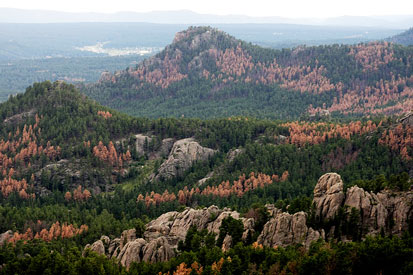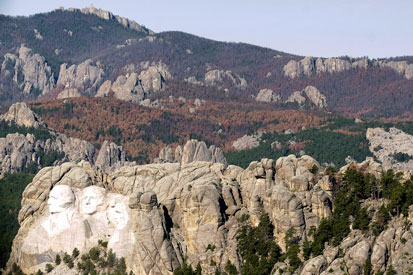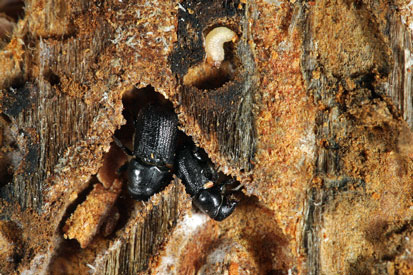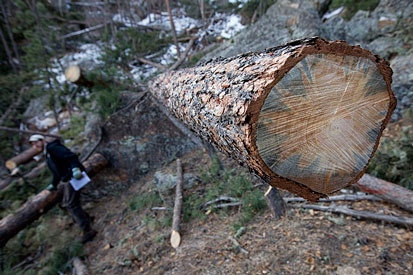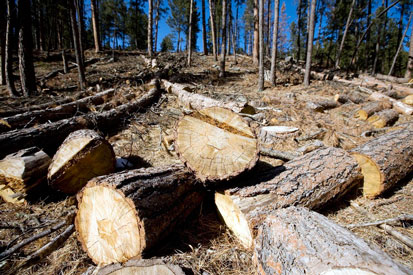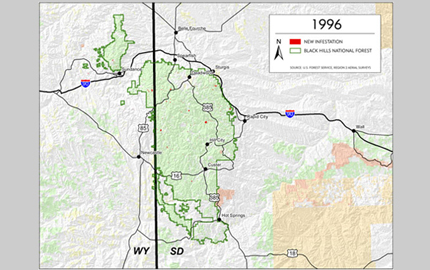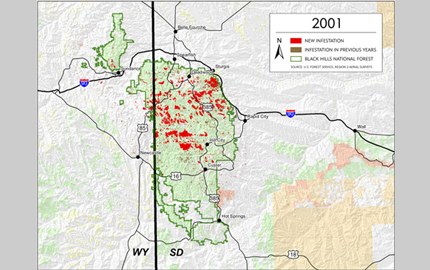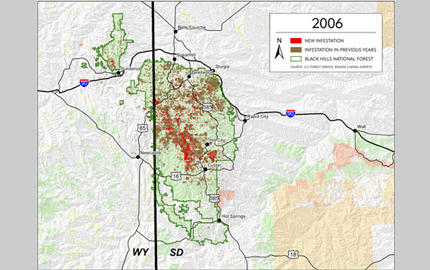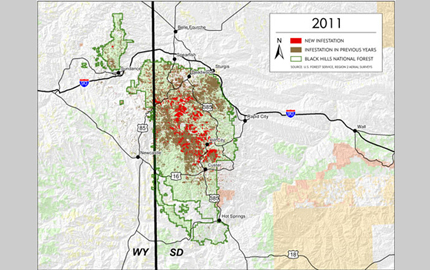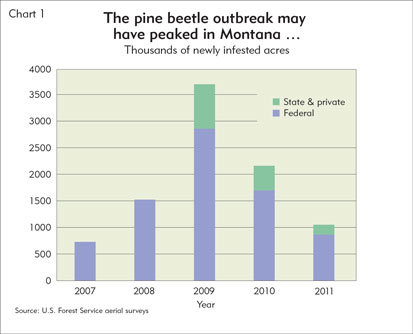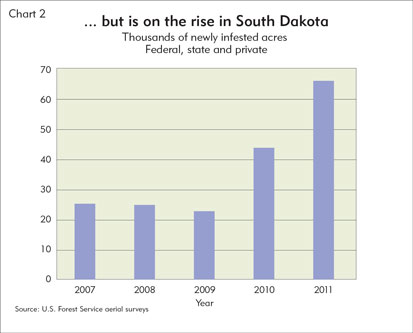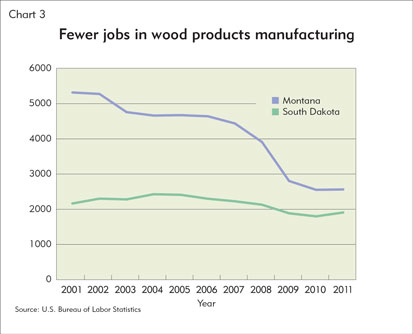Mountainsides of dead trees surround Sun Mountain Lumber, a sawmill in Deer Lodge, Mont. Over the past three years, the needles of countless lodgepole pines turned brown, then red, then dropped off to expose gray, lifeless trunks. The trees were killed by the mountain pine bark beetle, an insect that has ravaged thousands of square miles of pine forests in mountainous areas over the past 15 years, including western Montana and the Black Hills of South Dakota.
“The good news is, in this particular area, the beetle has kind of run its course,” said mill manager Tony Colter. Sun Mountain, the largest private employer in the Deer Lodge Valley with 145 workers, has weathered a severe housing slump and subsequent recession; production has steadily increased since 2010.
But the mill might be undone by a bug the size of a grain of rice; the pine beetle epidemic has drastically reduced the local supply of healthy lodgepole pine, the raw material for two-by-four studs and other dimensional lumber produced by the mill. “The bad news is that it killed over 90 percent of the lodgepole pine, and it’s probably not going to be merchantable within a year or two,” Colter said. “This gray timber is really losing its value quickly.”
While the landscape effects of the pine beetle infestation are stark, the economic effects of the epidemic are more subtle. Pines killed by the beetles have inconvenienced tourists, blighted backyards and spurred efforts by the U.S. Forest Service and state and local governments to try to curb the outbreak by cutting down infested trees.
But the beetle attack has most seriously affected forest products firms—loggers, sawmills and manufacturers trying to bounce back from the housing crash and, in Montana, reverse two decades of industry decline. Here, too, the impact has been double sided: There are good uses for infected logs, and for now widespread cutting has boosted timber supplies for many forest products firms. But much lumber from beetle-killed trees is lower grade than that milled from healthy trees, and because of their short shelf life most infested trees will ultimately go unused.
Most ominously for the industry, over the next few years the epidemic threatens to slash the supply of usable pine logs—ironically, just when housing starts and lumber demand are expected to rebound. “The potential for mill closures is definitely there, especially if they aren’t able to respond to increasing markets,” said Todd Morgan, an expert on the forest products industry at the University of Montana’s Bureau of Business and Economic Research.
Beetles on the march
Each fall, a new generation of mountain pine bark beetles takes up residence in the district’s western forests. Over the summer, swarms of the tiny, dark-shelled insect invaded pine trees, tunneling into the inner bark to lay eggs. The resulting larvae feed on the host tree—disrupting the flow of nutrients and eventually killing it—until the following summer, when they mature into adult beetles and take flight, infesting more trees.
Native to the western United States, the pine bark beetle thrives in old, dense pine forests under stress. Persistent drought combined with overcrowding due to over a century of wildfire suppression has weakened lodgepole, ponderosa and other species of pine, making them susceptible to colonization.
The current outbreak began in the mid 1990s and has steadily expanded its footprint to cover over 5 million acres of forest in Montana. The infestation appears to have peaked in the state—aerial surveys by the Forest Service in 2011 found 1 million acres of newly infested trees, about half the area affected the year before (Chart 1). But the beetles are still gaining ground in the Black Hills (Chart 2 and accompanying maps below).
Infestation has been spotty, with some areas of western Montana and the Black Hills affected much worse than others. For example, over the past decade beetles have left their mark on over 40 percent of the Helena National Forest in west-central Montana, and last year they made further inroads in the Bitterroot National Forest near the Idaho border. But so far, beetle kill has been light in the Flathead Valley and other parts of northwestern Montana.
In the Black Hills, the damage is concentrated in the central and northern hills, with heavy beetle kill on the northern edge of Custer State Park and hot spots near Lead, on the western fringes of Rapid City and around Mount Rushmore National Memorial—where for the past three years pines have been sprayed with protective insecticide.
To date, the infestation appears to have had little effect on tourism in Montana and the Black Hills—visitation numbers this summer were generally up over last year (see “Tourism survives beetle attack”).
But the epidemic has imposed costs on taxpayers and private landowners. The state of South Dakota has budgeted $6 million for a three-year campaign to control the beetles by felling trees on state and private land. In both western Montana and the Black Hills, property owners have borne the expense of removing dead or dying trees from their own land or public parkland in urban areas. In January, the city council in Rapid City passed an ordinance giving the city the authority to cut down infested trees on private property and bill the owners. Helena, Mont., which has lost thousands of ponderosa pines to beetles, raised property taxes in 2010 to fund a decade-long, $1.5 million effort to cut infested trees on open recreational space.
However, tree removal costs—and indirect or less tangible costs such as travel delays because of blocked roads and marred views for residents and visitors—are minor in comparison with the impact of the beetle epidemic on those who depend on trees for their livelihood. Like termites in a wood-frame house, pine bark beetles threaten the foundation of the forest products industry.
Salvaging value
Sawmills in the western part of the district have long complained about restricted log supply—or, more precisely, the cost of logs given declining production from many national forests—down 85 percent in Montana since the late 1980s. “That has really slowed the ability of [Montana] mills to get timber, even when [lumber] markets were good” in the 1990s and in the mid-2000s before the housing bust, Morgan said.
Thanks to the pine bark beetles’ depredation, more timber is now flowing to sawmills in areas of western Montana hard hit by the infestation and in the Black Hills.
In Montana, over 90 percent of beetle kill has occurred in its national forests, yet commercial logging there hasn’t increased. For the most part, Forest Service managers have focused on taking down beetle-killed trees where they pose a hazard to people or infrastructure—near settlements, along roads and power lines, and in campgrounds and other recreation areas. Much of this wood can only be sold for firewood or is left to rot.
But logging has increased on state and private lands in the state, offsetting the decline in Forest Service timber sales. Since 2007, commercial loggers have cut trees killed by mountain pine beetles and other insects on 7,000 acres of state trust lands, contributing to a 22 percent increase in state timber harvested last year compared with 2010. Revenue from timber sales—mostly to local sawmills—supports state schools and public universities. “We’ve been very aggressive about trying to capture the value” of beetle-killed timber, said Montana State Forester Bob Harrington.
In the Black Hills, national forestland supplies about 90 percent of saw timber. The average annual cut permitted by the Forest Service over a 10-year period fell by one-third in 1997 and has remained at that level. But since 2007, annual timber harvest in the Black Hills National Forest has exceeded the average annual allowable cut. Forest officials attribute higher harvest levels to logging of beetle-killed stands, coupled with strong demand from mills in the region.
Beetle-related cutting on state and private lands has also bolstered wood supplies in South Dakota. Under the state Black Hills Forest Initiative, a joint project with several counties in the region, crews have cut down more than 215,000 infested trees in Custer State Park and on private property over the past year. Private landowners have cut and sold tens of thousands more on their own. (In addition, noncommercial “bug tree” removal has boosted business for tree service firms in Rapid City and other Black Hills communities.)
A “blessing,” but …
A surge of beetle-killed timber has helped forest products firms ramp up production to meet rising demand from a construction industry that, if not booming, is showing signs of life. During the recession, annual production at Sun Mountain Lumber in Montana dropped by more than half, forcing the firm to lay off 30 workers. Over the past two years, annual output has bounced back to about 120 million board feet, allowing the firm to restore those positions.
Increasing production would have been more difficult without the “blessing in disguise” of extensive beetle kill, said Colter, the mill manager. Over the past four to five years, Sun Mountain and other mills in west-central Montana have purchased large amounts of beetle-killed lodgepole pine, mostly from private landowners. Over two-thirds of the lodgepole processed at Sun Mountain is beetle killed. “If we didn’t have the mountain pine beetle epidemic, there probably would be even less wood available for the mills that are operating,” Colter said.
Beetle-killed timber has also helped to sustain loggers who work under contract to sawmills or who cut and sell timber independently. Keith Olson, executive director of the Montana Logging Association, said that logging activity has been “steady,” even during the recession, because of beetle-related cutting on state and private land.
But there’s a problem with such timber, an almost literal fly in the ointment: It’s worth less than green wood because the beetles carry a fungus that leaves a blue tint on the outer rings of logs. This flaw makes much beetle-killed wood less desirable and has limited the amount of beetle-killed timber that mills can process.
Lumber marred by “blue stain” is structurally sound and fine for use in stud wall construction, where the wood is hidden behind sheetrock or paneling. But for some applications, this wood isn’t good enough. Colter of Sun Mountain says that some customers are willing to pay 10 percent to 15 percent more for unstained lumber milled from uninfected trees. But such trees are increasingly rare in the Deer Lodge Valley, and “those customers who are willing to pay a premium for green lodgepole are getting harder and harder to satisfy,” he said.
Some Montana mills, such as F. H. Stoltze near Columbia Falls, have shunned blue-stained wood, preferring to seek out uninfested lodgepole or use tree species unaffected by pine beetles, such as Douglas fir and larch.
Blue stain is particularly troublesome for forest products firms in the Black Hills, which primarily produce lumber for visible finish applications such as home interiors and decks. (In contrast, a higher proportion of Montana’s output consists of basic framing lumber.)
Neiman Enterprises is the biggest forest products company in the Black Hills with 430 employees at mills in Spearfish and Hill City, S.D., and Hulett, Wyo. The bulk of its revenue comes from the manufacture of boards, paneling and molding for home construction and remodeling. But blue-stained ponderosa pine can’t be used in those products, said resource manager Dan Buehler; consumers find the color off-putting, a sign of mold or rot. Instead, many of the 600,000 beetle-killed trees Neiman processes annually end up in particle board, crating and inexpensive painted furniture.
The company restricts its use of blue-stained logs to about one-third of its total intake. “If we get beyond that, we’re basically making product that sits in the yard,” Buehler said. “We can’t make a profit if we can’t get rid of it.”
Because of blue stain and other problems with beetle-killed timber—it can be harder to process and its dryness increases fire risk in mills—the region’s forest products industry can’t process all the available beetle-killed wood, said Carson Engelskirger, former forest programs manager for the Black Hills Forest Resource Association. “This thing has festered, and now it’s bigger than us,” he said.
A changed forest
The looming uncertainty for the forest products industry is how this infestation plays out over the next few years, with consequences for decades to come. Pine tree seedlings in regenerating stands take 60 to 100 years to grow into harvestable timber.
Some efforts are being made to stanch the beetle’s spread. Forest Service officials in the Black Hills have proposed treating 248,000 acres of recently infested tree stands in hope of slowing or halting the advance of the beetles. A drought-ending change in the weather could also tamp down the infestation in some areas. But for the most part, the infestation is expected to run its course, abating when the beetles have consumed most of their preferred host—mature pine trees.
An ongoing severe infestation would put additional pressure on a beleaguered industry. In Montana, employment in wood products manufacturing fell by more than half between 2001 and 2011 as operations closed or consolidated (Chart 3). Logging and private forestry jobs also declined precipitously over that period. In South Dakota, wood products manufacturing has held up better, but the industry still shed about 500 jobs since 2004.
Further retrenchment wouldn’t significantly harm the economies of either Montana or South Dakota; in both states, the forest products industry accounts for less than 1 percent of total nonfarm employment, according to government figures. But forestry, logging and wood manufacturing still support scores of jobs in communities such as Deer Lodge, Columbia Falls, Spearfish and Rapid City.
A prolonged beetle infestation would likely inflict more hardship on forest products firms in the Black Hills than those in western Montana. In both places, tighter pine supplies could drive up log prices, especially if demand for lumber rises with an expected housing rebound. But Montana sawmills have a greater ability to adapt their product lines to whatever logs are available at the lowest price. Beetle-proof Douglas fir makes up about 30 percent of incoming logs at Sun Mountain. Colter foresees that percentage increasing if healthy lodgepole pine becomes more expensive. “At least as far as our mill is concerned, there will be a shift to more Douglas fir,” he said.
Switching to other types of trees isn’t an option in the Black Hills, because loggers and wood products firms depend on a single species, ponderosa pine, growing in a region cut off from other sources of logs. Shipping in timber from other states such as Montana or Idaho is too expensive. “We’re on an island, and we have this bug epidemic, and it’s chewing through the forest. … If we let the island get eaten up, we lose; everybody loses,” Engelskirger said.
Buehler of Neiman Enterprises said that if the epidemic worsens, the company may have no option but to close one of its mills, perhaps within five years.
More trees and forest products jobs could be lost in Montana and the Black Hills if large wildfires break out in dead pine stands—a scenario feared by tourism businesses and many residents as well as sawyers and mill operators. Fire has scorched thousands of square miles of forests decimated by pine bark beetles in Colorado, Idaho and other states.
What’s certain is that after the pine beetle infestation subsides, other insect pests and diseases will afflict trees and vex forest products firms in the district. Last year’s Forest Service aerial survey identified over 1 million acres in Montana affected by western spruce budworm, a moth that attacks spruce and fir trees.
To endure, the forest products industry must adapt not only to changing market conditions, but also to “whatever comes out of the forest, given the different disturbances, whether it’s fire or different kinds of insect diseases,” Morgan said.



